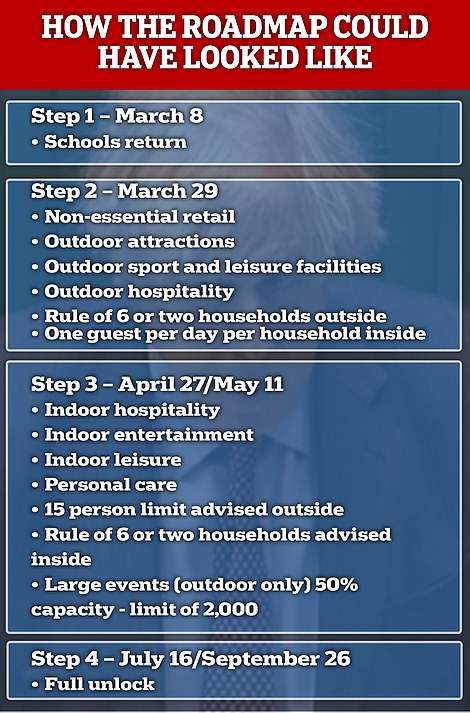
Boris Johnson’s blueprint for lifting lockdown could have factored in indoor mixing sooner and still kept hospital bed occupancy levels at the lowest level they are likely to reach in an inevitable third wave, SAGE modelling has suggested.
The Prime Minister today laid out his ‘one-way road to freedom’ in plans to bring in the Rule of Six and mixing of two households outdoors by the end of March, with indoor socialising set for May 17 at the earliest.
However, one plan suggested by SPI-M, a sub-group of SAGE, suggested people could welcome solo visitors into their homes as early as March 29 while keeping most other factors roughly the same as No10’s plan.
SAGE’s modelling shows a third wave of coronavirus infections and hospital admissions will be inevitable when lockdown rules are loosened, with the numbers of people on wards with Covid approaching levels close to, or higher than, the first wave in the spring of 2020.
In a worst-case scenario, another 150,000 people could die before next summer, government advisers led by a team including ‘Professor Lockdown’ Neil Ferguson warned. Although this figure varies depending on how quickly lockdown ends.
One model warned of another 80,000 deaths between now and next June, if No10 acts too quickly.
The models were different lockdown-lifting scenarios suggested by the Cabinet Office, which scientists then predicted the effects of. The Government does not appear to have opted for any of the oven-ready scenarios in SAGE’s modelling but to have created a hybrid that brings forward some relaxations and pushes others back.
Lifting rules earlier but in a controlled manner could keep the hospitalisations below the first wave peak but bring the third wave forward so that it happens in the summer, when the pressure on the NHS is low, instead of winter.
Separate modelling by the Imperial team — whose grisly projections spooked ministers into the first lockdown last spring — warned that keeping some restrictions until January would be the safest route back to normality.
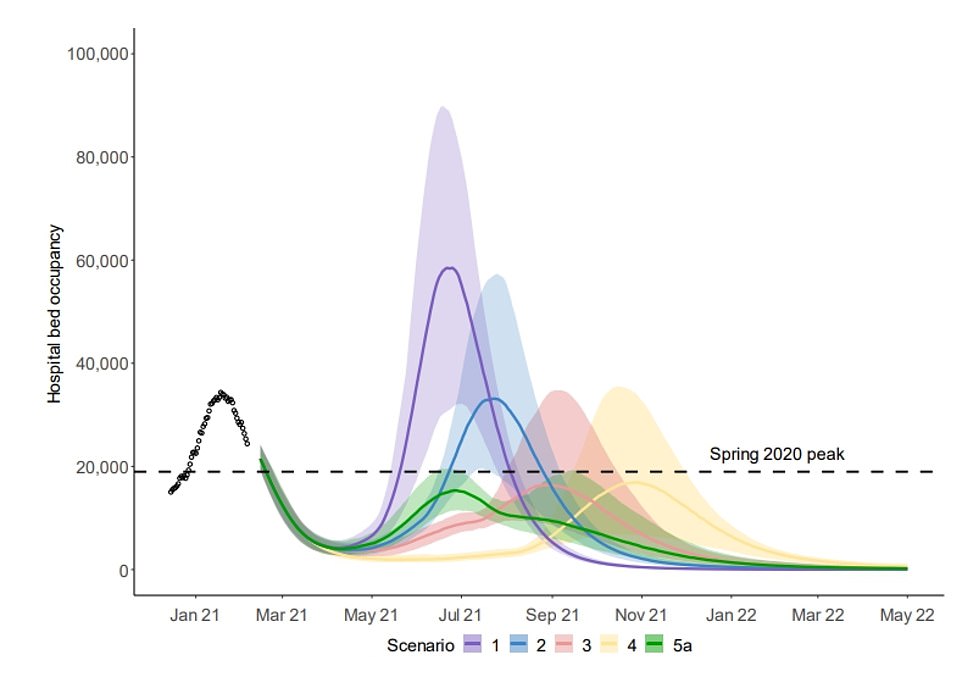
SAGE modelling presented to the Government found that one-on-one indoor mixing could be brought back at the end of March and the inevitable third wave still kept under control. Graph shows how all lockdown-lifting scenarios eventually lead to a third spike in the number of people in hospital – the green line appears to track closely to Mr Johnson’s plan to lift lockdown, but factored in indoor mixing as soon as March 29. It brings forward the next spike in NHS pressure to the summer, when the NHS is less busy, instead of pushing it back to the winter. Modelling conducted by Imperial researchers
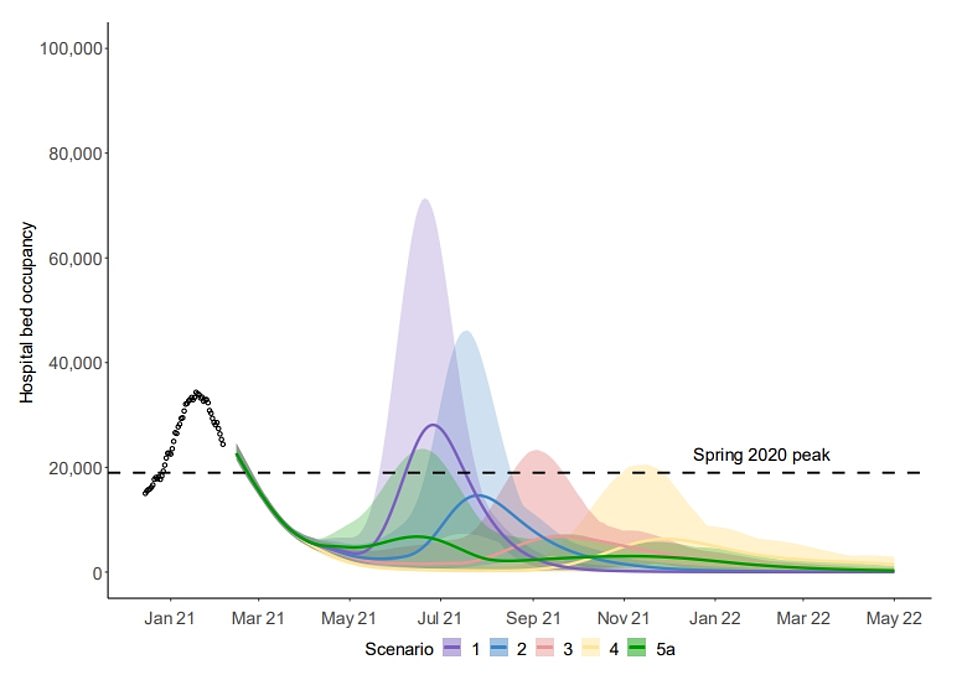
A second modelling scenario confirmed that one-on-one indoor mixing being reintroduced in March (scenario 5a, the green line) could be part of a method that keeps the hospital bed occupancy below the first wave peak. Modelling conducted by a separate Warwick University team
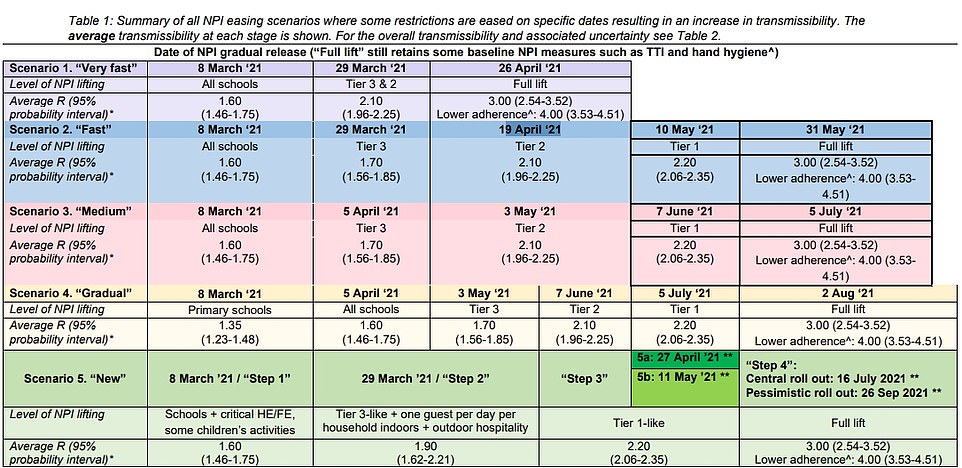
Boris Johnson’s lockdown plan, announced today, appears to track closely to scenario 5, which will likely allow the R rate to surge to 2 or higher by the end of April, but some parts have been pushed back
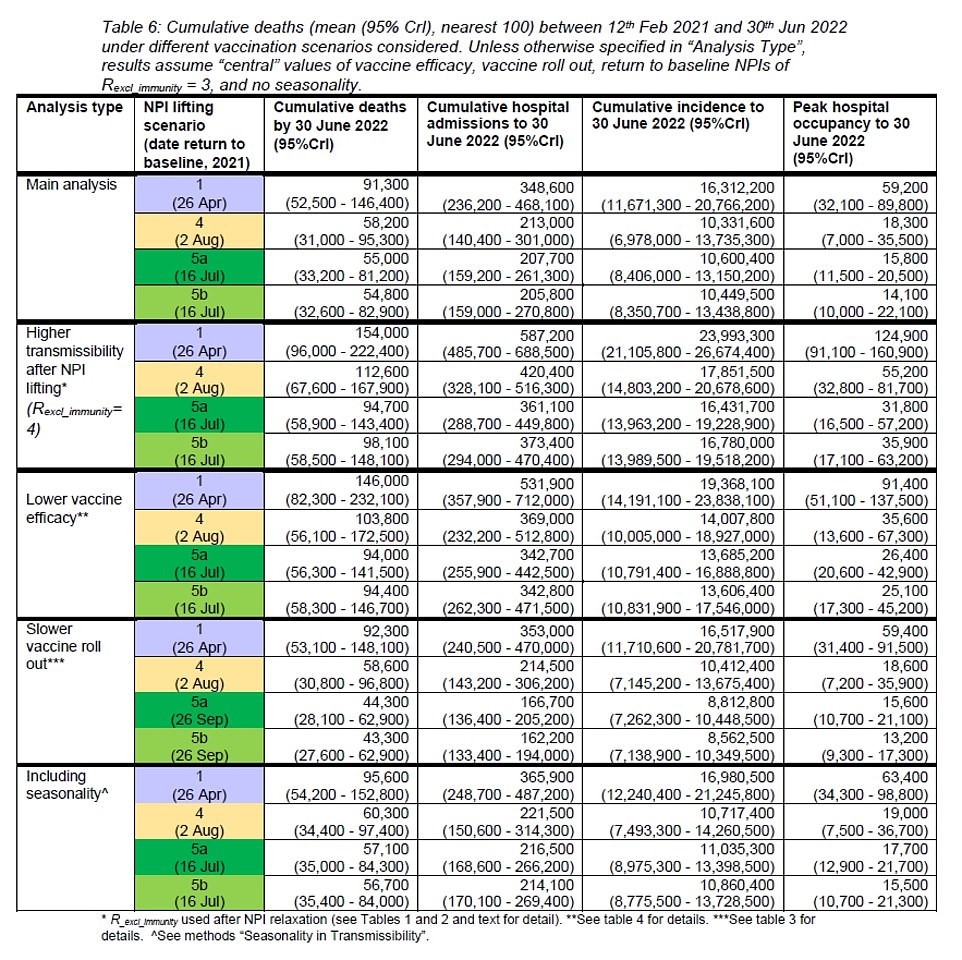
In a worst-case scenario, another 150,000 people could die before next summer, the government advisers warned. Although this figure varies depending on how quickly lockdown ends. One model warned of another 80,000 deaths between now and next June, if No10 acts too quickly
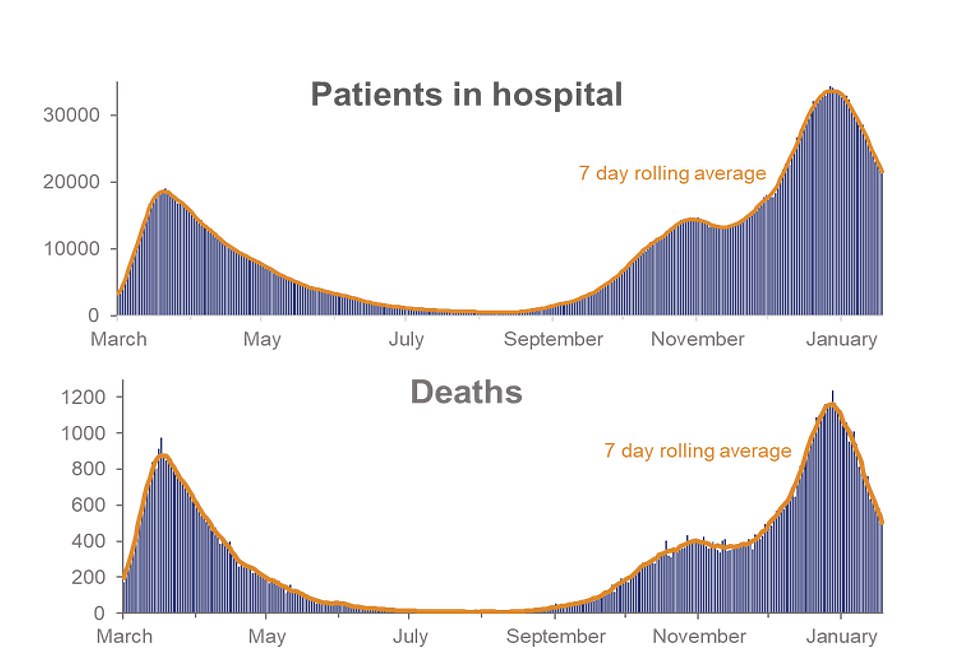
What were the five different scenarios Imperial scientists modelled for SAGE?
SCENARIO 1 (PURPLE)
March 8: All schools reopen March 29: Mix of Tier 3 and 2 rules nationwide April 26: Full lifting of restrictions
ADDITIONAL DEATHS: 91,300
ADDITIONAL HOSPITAL ADMISSIONS: 348,600
PEAK HOSPITAL OCCUPANCY (COVID): 59,200
SCENARIO 2 (BLUE)
March 8: All schools reopen March 29: Tier 3 nationwide April 19: Tier 2 nationwide May 10: Tier 1 nationwide May 31: Full lifting of restrictions
ADDITIONAL DEATHS: NOT SPECIFIED
ADDITIONAL HOSPITAL ADMISSIONS: NOT SPECIFIED
PEAK HOSPITAL OCCUPANCY (COVID): NOT SPECIFIED
SCENARIO 3 (RED)
March 8: All schools reopen April 5: Tier 3 nationwide May 3: Tier 2 nationwide June 7: Tier 1 nationwide July 5: Full lifting of restrictions
ADDITIONAL DEATHS: NOT SPECIFIED
ADDITIONAL HOSPITAL ADMISSIONS: NOT SPECIFIED
PEAK HOSPITAL OCCUPANCY (COVID): NOT SPECIFIED
SCENARIO 4 (YELLOW)
March 8: Primary schools reopen April 5: All schools reopen May 3: Tier 3 nationwide June 7: Tier 2 nationwide July 5: Tier 1 nationwide August 2: Full lifting of restrictions
ADDITIONAL DEATHS: 58,200
ADDITIONAL HOSPITAL ADMISSIONS: 213,000
PEAK HOSPITAL OCCUPANCY (COVID): 18,300
SCENARIO 5 (GREEN)
March 8: All schools reopen March 29: Tier 3-like restrictions/One visitor allowed inside your home/Outdoor hospitality reopens April 27/May 11: Tier 1-like measures July 16/September 26: Full lifting of restrictions
ADDITIONAL DEATHS: 55,000/54,800
ADDITIONAL HOSPITAL ADMISSIONS: 207,700/205,800
PEAK HOSPITAL OCCUPANCY (COVID): 15,800/14,100
Source: Imperial College London’s file submitted to SAGE, titled ‘Unlocking Roadmap Scenarios for England v2’
Advertisement
The blueprint for lifting lockdown, outlined by Mr Johnson today and expected to be eased over March, April, May and June, is expected to see the R rate of the virus rise higher than 2 before the end of April.
This rate – which measures how many people each person with coronavirus infects – will be higher than at any point since the very beginning of the pandemic.
But it is hoped that widespread vaccination – more than 17.5million people have been vaccinated already and all adults in the UK are likely to have been offered a jab by the time lockdown is lifted completely – will prevent millions of infections and thousands of hospital admissions and deaths.
Children and teenagers are set to bear the brunt of the third wave, with no vaccination coverage among over-18s and schools likely permanently reopened.
Data published today for the first time suggest that the jabs already being used in Britain – made by Pfizer and AstraZeneca – are already preventing between 85 and 94 per cent of hospital admissions among people who have had them, and Pfizer’s jab may be stopping upwards of 70 per cent of people from becoming infected.
But the Government’s top scientists sounded alarm bells in a briefing with journalists this morning, insisting that the easing of lockdown must be led by ‘data not dates’.
Dame Angela McLean, deputy chief scientific adviser, said: ‘One of the things that is very clear is this could go wrong if we go about things the wrong way.’
Gloomy modelling presented to SAGE suggested that another 143,000 Britons could die by July 2022 if No10 releases lockdown restrictions too early.
The analysis presented to SAGE – the Government’s panel of top scientific advisers – took into account several different time-frames for completely easing the draconian restrictions.
The most alarming model took into account placing the nation back into Tier 2/3-style measures on March 29 and then fully lifting lockdown on April 26.
The blueprint – made by ‘Professor Lockdown’ Neil Ferguson and his Imperial team – warned that it could lead to another 154,000 deaths between now and next June.
In comparison, the additional death toll would be kept under six figures if ministers waited until July 16 to ease all restrictions.
Separate modelling was also conducted by Warwick University researchers, which came to similar conclusions.
In his roadmap today Mr Johnson signalled that lockdown is unlikely to be lifted before July, saying the final step of easing restrictions would happen no earlier than June 21.
A model of possible ways to ease out of lockdown, produced by the Imperial College Covid-19 Response Team, put forward the prospect of allowing one-on-one meetings indoors from March 29.
Under this scenario, hospital admissions could be kept below the first wave peak of 20,000 people in hospital with the disease, but the third wave would be brought forward to begin in May or June and rumble on through the summer.
This third wave, however, is inevitable.
Under the early mixing rule the peak of the third wave is no higher than in other models, it just comes sooner and appears to last slightly longer.
A peak in the summer would be safer for the NHS, which is typically over-stretched even in an average winter.
And the earlier spike that comes as part of a plan dubbed ‘scenario 5’, SPI-M suggested, may develop some herd immunity among younger people spreading the virus over the summer.
The paper, dated February 17, said: ‘Prevalence in scenario 5 (and therefore hospital occupancy) is higher in summer than in the previous scenarios 2 and 3 as the first two steps happen more quickly.
‘This means that fewer people are still susceptible at step 4 [total lifting of lockdown].
‘Tying the timing of the final step to the date at which the whole population have been offered at least one dose, limits the height of the second peak compared to easing restrictions earlier.’
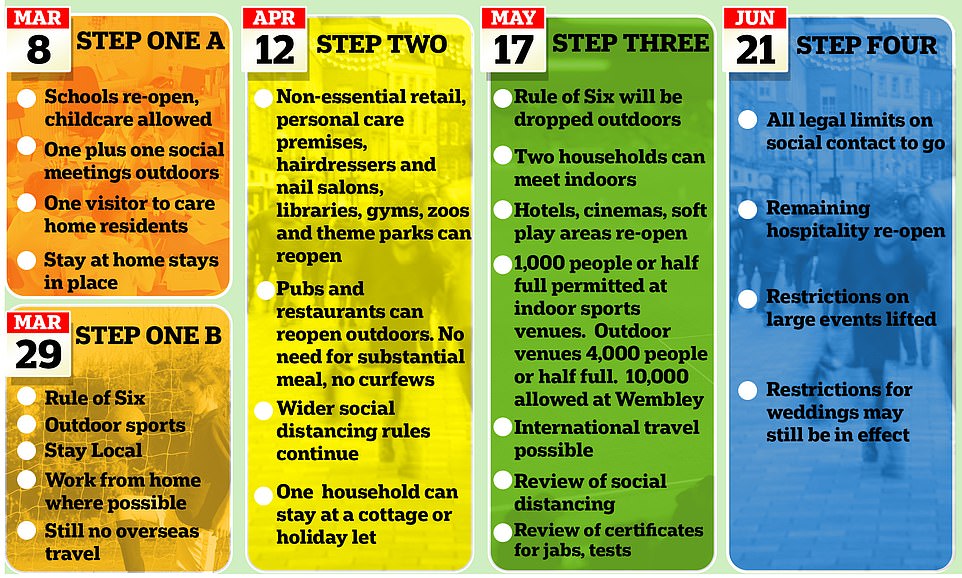
Boris Johnson today unveiled his lockdown exit strategy with rules due to start being lifted from March 8
SUMMER CIRCUIT BREAKER ON THE CARDS
School summer holidays would be an ideal place for a circuit-breaker lockdown if Covid cases are spiralling out of control because of tough restrictions being eased, Number 10’s top scientists have claimed.
SPI-M-O, a sub-group of SAGE, said Easter would be a ‘natural time during which to take stock and assess’ how reopening schools have impacted transmission.
They added that another good time to reassess whether easing lockdown measures have gone too far would be over an extended summer half-term holiday, scheduled for the first week of June in England.
Writing in a consensus statement presented to SAGE on February 10, the panel said: ‘If prevalence appears to be increasing, introducing a circuit break of two to three weeks over this half-term could be beneficial.
‘If prevalence is low and stable during the first half of the summer term, this could be cancelled.
Advertisement
As well as considering the timing of restrictions being lifted, the modelling also looks at how well the vaccine rollout progresses and how effective the vaccines are at preventing Covid-19.
It assumes that vaccines prevent between 50 and 94 per cent of infections, 50 and 94 per cent of symptomatic cases of Covid, and 70 and 98 per cent of severe cases after two doses.
These may be pessimistic estimates, based on studies that were published today suggesting that the Pfizer jab appeared to be preventing at least 70 per cent of infections among healthcare workers, and both jabs were preventing over 85 per cent of severe Covid cases after just a single dose.
The Imperial College model suggested that if vaccines were at the low end of effectiveness and lockdown was lifted completely in April, there could be another 146,000 deaths before July 2022.
This could be kept down to 94,000 deaths if lockdown were reduced more gradually up to a total relaxation in July.
Equally, if the vaccine rollout went slower than its current pace but the jabs were highly effective, as expected, deaths would be between 43,000 for the later end to lockdown up to 92,000 with the early lifting.
Professor Ferguson’s team warned: ‘Due to eligibility and vaccine hesitancy, vaccination alone will not be sufficient to keep the epidemic under control. [Lockdown rules] must be lifted slowly and cautiously to minimise the number of deaths and prevent high hospital occupancy, with some baseline [rules] remaining in place (and adhered to) throughout 2021 and beyond…
‘Relaxing too quickly will result in peak hospital occupancy considerably higher than the current wave and substantial additional deaths. This holds regardless of vaccine efficacy, rollout, adherence to baseline [restrictions], and impact of seasonality.’
The paper suggested that even a high-speed vaccine rollout reaching 3.2million doses per week – 2.5m were administered last week – may only lead to two thirds of the country developing immunity by the middle of summer.
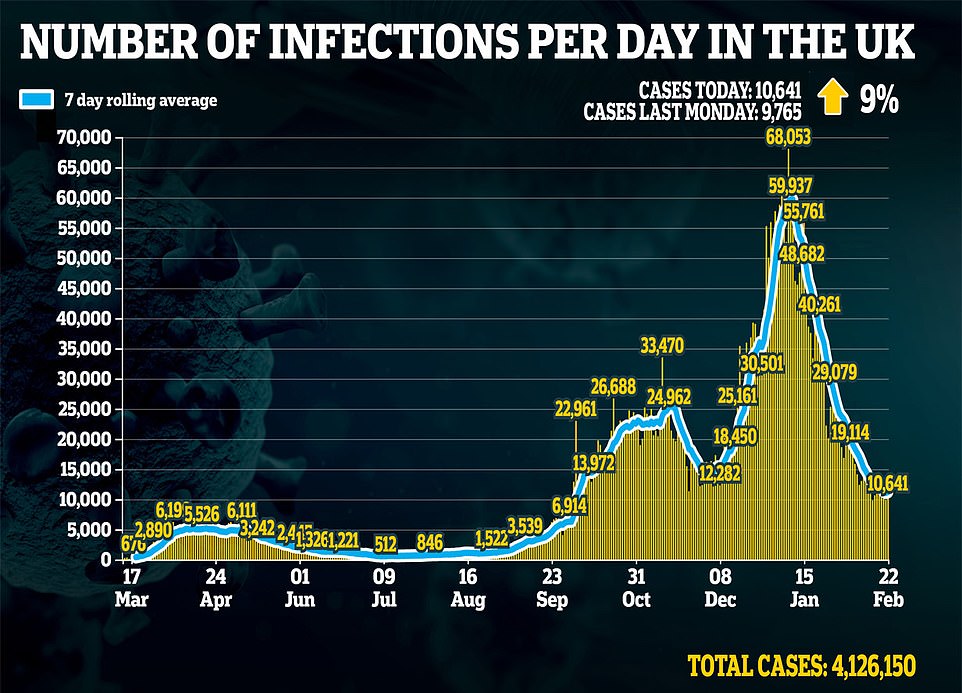
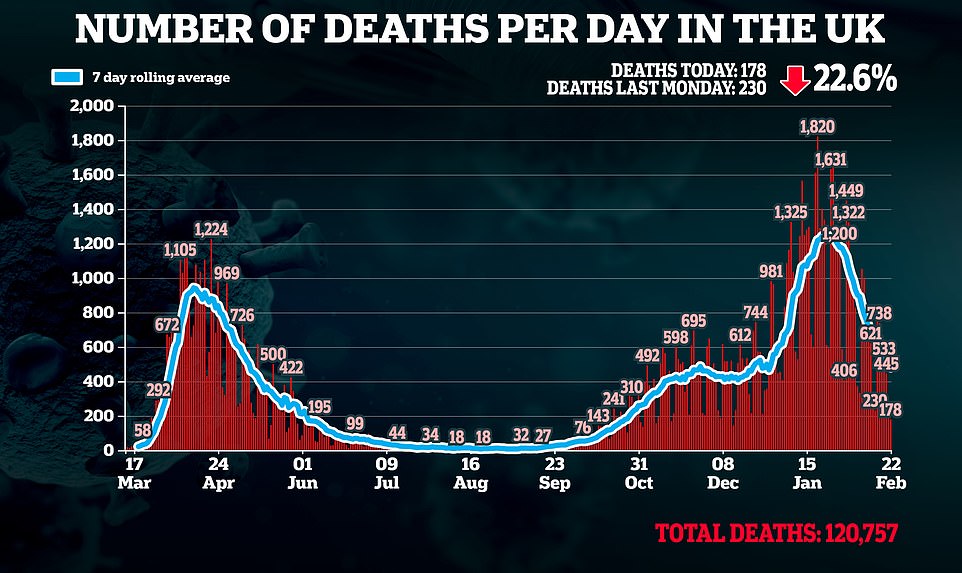
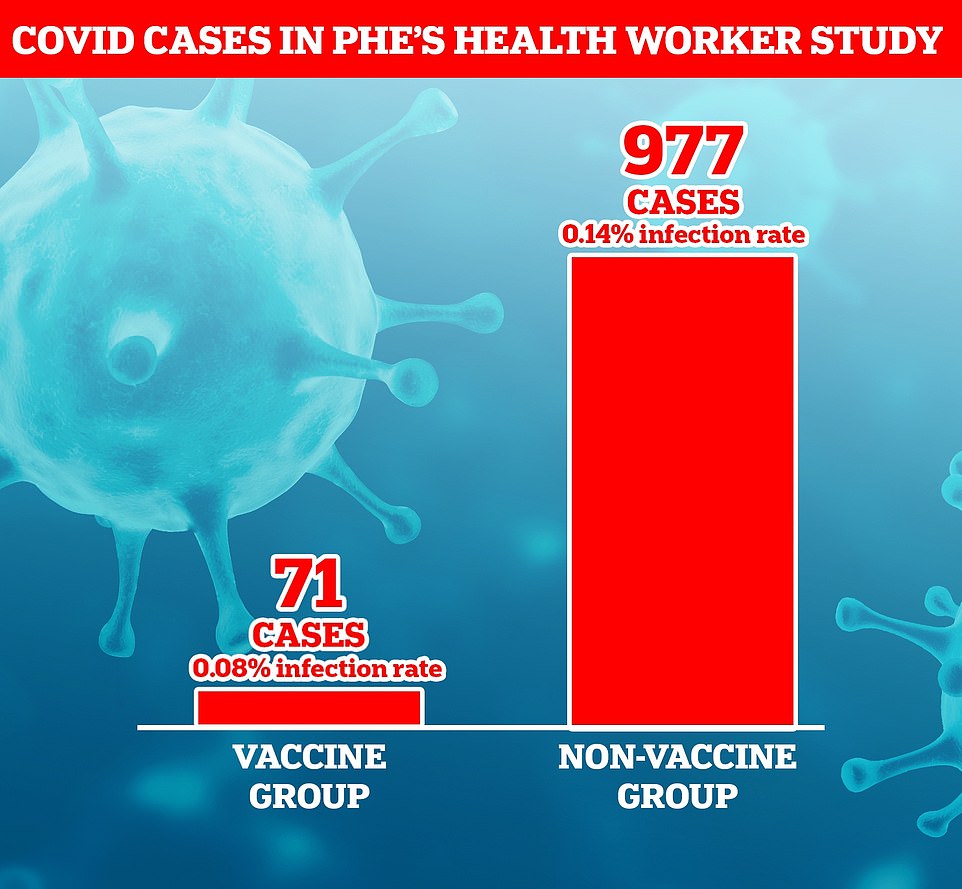
Out of 23,324 health workers in the study, 89 per cent were vaccinated by February 5. There were 977 cases of coronavirus recorded in people before they were vaccinated, compared to 71 among people who were three weeks post-vaccination, PHE’s Dr Susan Hopkins said today
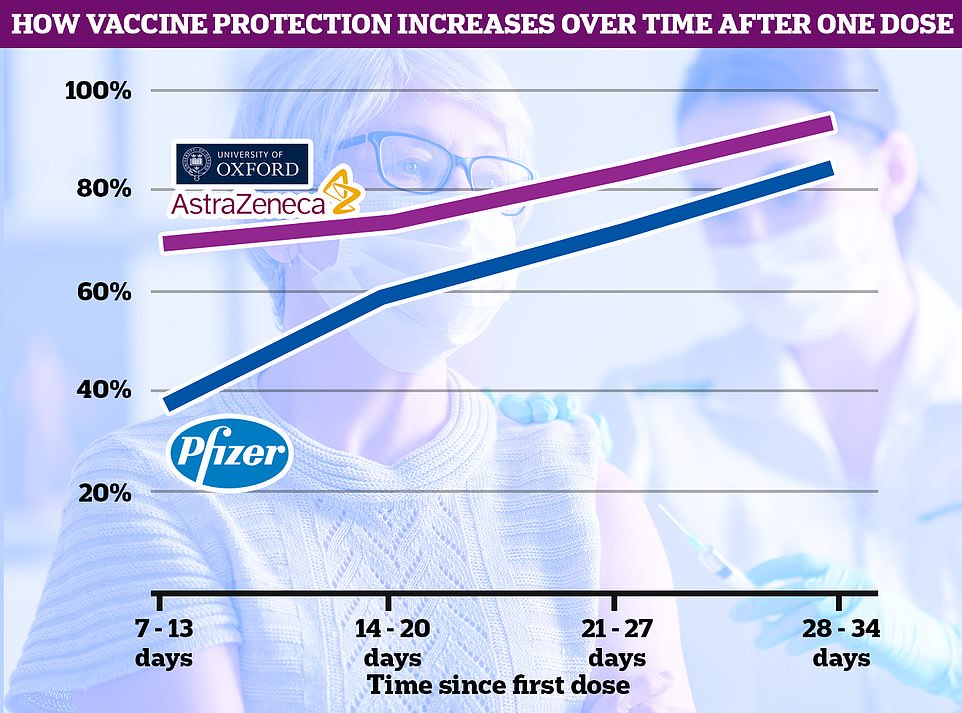
The Scottish study showed that both vaccines offer a high level of protection against being hospitalised with Covid from just two weeks after a single dose, with the protection kicking in only a week after injection. There were not enough data to compare the two, the scientists said, although AstraZeneca’s appears to work better in the early stages
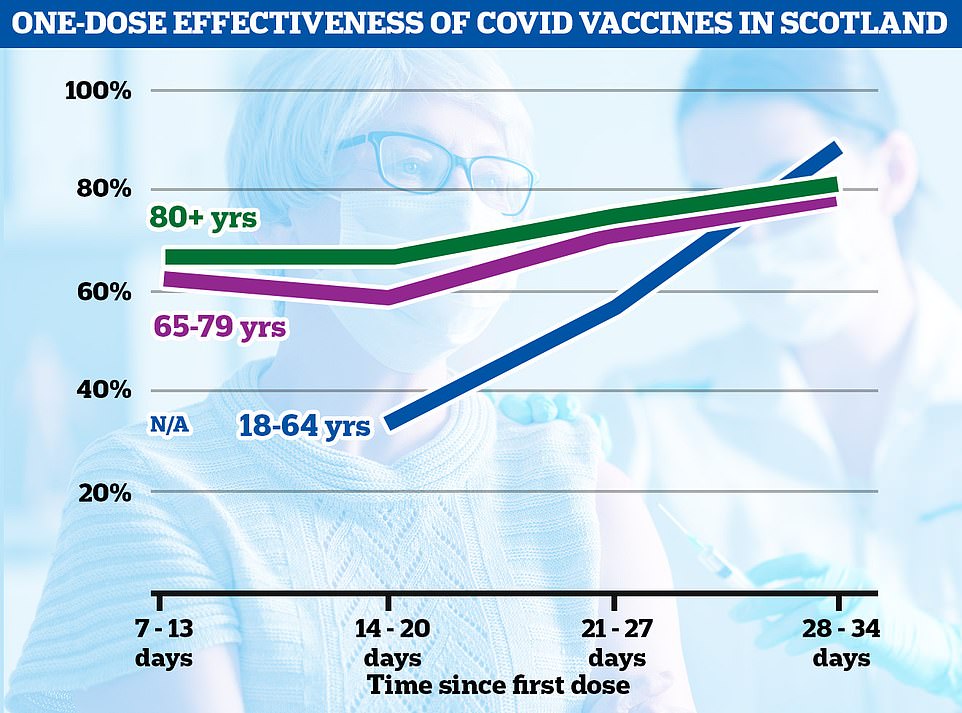
In a ray of hope for Britain’s lockdown-easing plans, results showed the jabs slashed the risk of hospital admission from Covid by up to 85 and 94 per cent, respectively, four weeks after the first dose. The graph above shows how the vaccine worked in different age groups
PUBLIC HEALTH ENGLAND AND SCOTLAND STUDIES SHOW SINGLE-DOSE VACCINES ARE WORKING ‘SPECTACULARLY WELL’
Covid vaccines being used in Britain are working ‘spectacularly well’ at slashing hospital admissions in Scotland and preventing even mild infections among health workers in England, the first real-world data revealed today.
Public Health England and top researchers in Scotland have published two separate papers linking up coronavirus data with vaccinations, revealing that jabs are both bringing down hospital admissions and preventing infections.
A single dose of Pfizer’s vaccine can cut the risk of testing positive with or without symptoms by 70 per cent, PHE found, rising to 85 per cent after a second jab.
And a dose of either Pfizer and AstraZeneca reduces someone’s risk of developing Covid severe enough to need hospital treatment by between 85 and 94 per cent, according to a separate study in Scotland.
PHE’s study showed that the Pfizer jab gave 57 per cent protection against Covid among over-80s from dose one, and this appeared to rise to 88 per cent after a second jab, although this data is preliminary. There was not enough information to make the same analysis for Oxford/AstraZeneca’s jab.
Experts dubbed the findings ‘very encouraging’, ‘a good sign’ and ‘reasons to be optimistic’ – they come as Boris Johnson today outlines Britain’s route out of lockdown, with schools expected to properly reopen in England from March 8, with further measures being loosed in the following weeks.
Government advisers on SAGE are still cautious, warning that 94 per cent protection ‘is not 100 per cent’ and that millions will still be at risk of Covid even with high vaccine coverage.

Out of 23,324 health workers in the PHE study, 89 per cent were vaccinated by February 5. There were 977 cases of coronavirus recorded in people before they were vaccinated, compared to 71 among people who were three weeks post-vaccination, PHE’s Dr Susan Hopkins said today
Public Health England today published the results of its SIREN study, which looks at how coronavirus is affecting medical workers across the country.
Medical staff have been among the top priority groups for vaccinations and also at a high risk of catching the virus during the second wave, so they are an extremely useful group for studying the effectiveness of the jabs.
Out of 23,324 health workers in the study, 89 per cent were vaccinated by February 5. There were 977 cases of coronavirus recorded in people before they were vaccinated, compared to 71 among people who were three weeks post-vaccination, PHE’s Dr Susan Hopkins said today. A further nine tested positive within a week of the jab.
The PHE epidemiologist told a news briefing: ‘Overall we’re seeing a really strong effect at reducing any infection.’
The study summarised the protection against coronavirus infection of any severity to be ‘at least 70 per cent 21 days after the first dose, increasing to at least 85 per cent 7 days after the second dose.’
Preventing people from testing positive for the disease almost certainly means that the vaccines will stop transmission, which is a boon for the Government’s plans to end lockdown this summer.
Clinical trials had not studied this before, instead looking only at symptomatic infection, hospital admissions or deaths. These are most important for preventing people from dying, but stopping the virus spreading is crucial for returning life to normal.
PHE also published separate data from a group of 148,052 over-70s showing that the vaccine protects elderly people (over-80) against Covid-19 symptoms by a factor of 57 per cent three weeks after the first dose. This is then boosted to more than 85 per cent after the second dose.
In all age groups people’s risk of getting such bad Covid that they need to go to hospital drops by over 75 per cent after a single dose of Pfizer’s jab, PHE said. For over-80s there is a 40 per cent reduction.

In a ray of hope for Britain’s lockdown-easing plans, results showed the jabs slashed the risk of hospital admission from Covid by up to 85 and 94 per cent, respectively, four weeks after the first dose. The graph above shows how the vaccine worked in different age groups

The Scottish study showed that both vaccines offer a high level of protection against being hospitalised with Covid from just two weeks after a single dose, with the protection kicking in only a week after injection. There were not enough data to compare the two, the scientists said, although AstraZeneca’s appears to work better in the early stages

For illustrative purposes, an 85 per cent reduction in the risk of hospitalisation could have meant that, if the UK’s entire adult population were vaccinated before the second wave, the 4,576 new coronavirus-related hospital admissions at the peak on January 12 could have been just 690 – 15 per cent of the total
And the risk of death among people older than 80 is lowered by 56 per cent from two weeks after a first dose of Pfizer’s vaccine.
Dr Mary Ramsay, the head of immunisation at PHE said: ‘This is strong evidence that the Pfizer/BioNTech vaccine is stopping people from getting infected, while also protecting cases against hospitalisation and death.’
She said people should be ‘very encouraged’ by the data but added: ‘Protection is not complete, and we don’t yet know how much these vaccines will reduce the risk of you passing Covid-19 onto others.
‘So even if you have been vaccinated, it is really important that you continue to act like you have the virus, practice good hand hygiene and stay at home.’
PHE’s study comes after research published this morning by Public Health Scotland, the University of Edinburgh and the University of Strathclyde, among others, that showed both Pfizer and Oxford’s jabs are working north of the border.
Using real-world data from members of the public – the first of its kind in the UK – the researchers found that the vaccines led to an 85-94 per cent reduction in hospital admission from four weeks after the first dose.
That study was based on an analysis of data from the 1.14million doses dished out between December 8 and February 15.
It linked up people’s vaccination records to reports of hospital admissions for Covid-19 to see whether people who had had a jab were coming less often than those who hadn’t.
It showed that among those aged 80 and over — one of the highest risk groups — vaccination was associated with an 81 per cent reduction in hospitalisation risk in the fourth week, when the results for both vaccines were combined.
Protection increased over time for both vaccines, from 38 per cent (Pfizer) and 70 per cent (Oxford) after one week – before the jab is expected to work at all – to 85 per cent (Pfizer) and 94 per cent (Oxford) after four weeks.
Professor Aziz Sheikh, the study director from the University of Edinburgh, said: ‘Overall we are very, very impressed with the both the vaccines. When you move beyond the trial settings you never know what the results are going to be.
‘Out in the field… both of these are working spectacularly well.’
Advertisement
Source link : https://www.dailymail.co.uk/news/article-9287163/Coronavirus-UK-Indoor-mixing-reintroduced-sooner-SAGE-suggests.html











